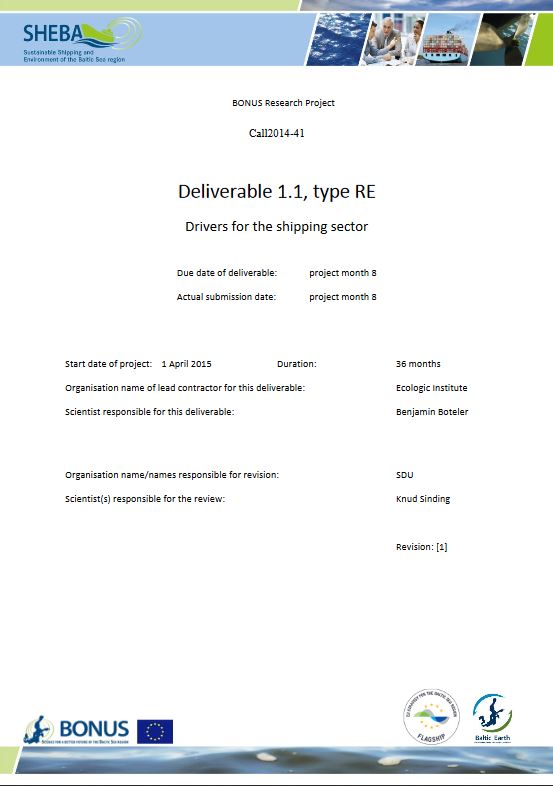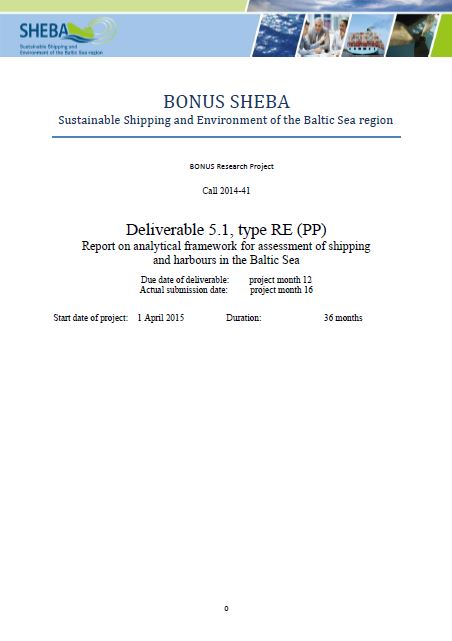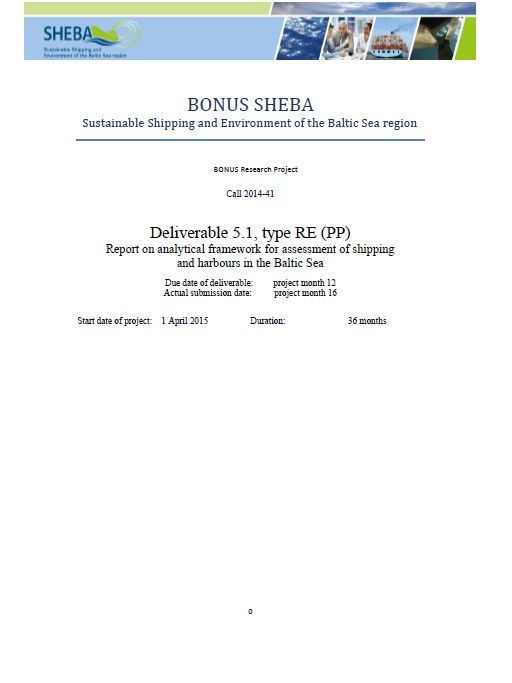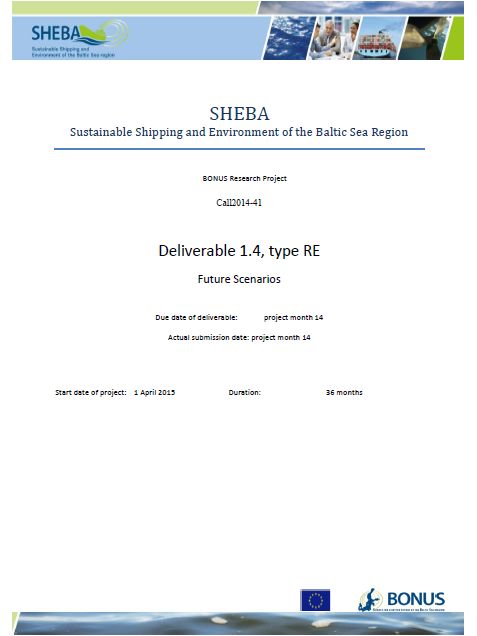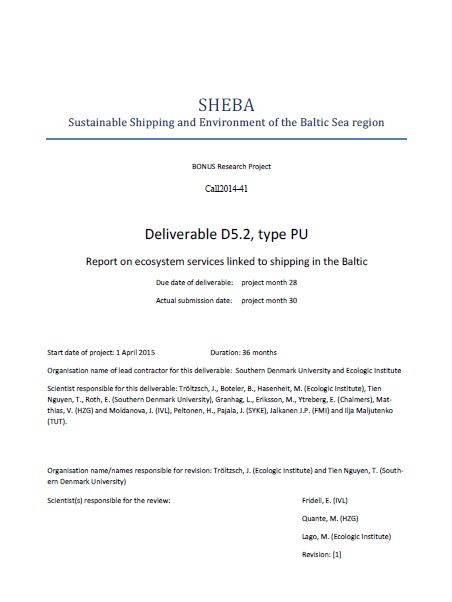Policy Evaluation and Tradeoffs to Reduce Environmental Pressures of Shipping in the Baltic Sea
Deliverable 5.3 – Sustainable Shipping and Environment of the Baltic Sea Region (SHEBA)
- Publikation
- Zitiervorschlag
Tröltzsch, Jenny et. al. 2015: Report on Policy Evaluation and Tradeoffs to Reduce Environmental Pressures of Shipping in the Baltic Sea. Deliverable 5.3. BONUS Research project Sustainable Shipping and Environment of the Baltic Sea Region (SHEBA).
Ziel dieses Berichts ist es, eine sozioökonomische Bewertung für die Bewertung von politischen Optionen vorzulegen, die das Potenzial haben, die Umweltbelastung durch die Schifffahrt in der Ostsee zu verringern und sich auf politische Ziele, insbesondere auf EU- und globaler Ebene, zu konzentrieren. Der Bericht beschreibt die Bewertung von 20 ausgewählten politischen Optionen, die sich auf unterschiedliche Umweltbelastungen durch die Schifffahrt konzentrieren.
Die Bewertung basiert auf einem entwickelten mehrdimensionalen Bewertungsrahmen, der acht Bewertungskriterien umfasst (politische Umsetzbarkeit, Akzeptanz und Machbarkeit, wissenschaftliche Erkenntnisse und Unsicherheiten, technologisches und innovatives Potenzial, Umwelt- und Gesundheitsergebnisse, Effizienz, Verteilungseffekte, Synergien und Kompromisse). Im Rahmen der Bewertung der politischen Optionen werden ihre potenziellen Auswirkungen auf die verschiedenen Umweltbelastungen sowie auf die menschliche Gesundheit und die Ökosystemdienstleistungen wie die kommerzielle Fischerei oder Freizeit und Tourismus analysiert. Das Ergebnis ist eine semi-quantitative und partizipative multikriterielle Bewertung.
- Sprache
-
Englisch
- Autorenschaft
-
Roth, E. (SDU)Matthias, V., Quante, M. (HZG)Fridell, E., Moldanova, J. (IVL)Jalkanen, J.- P. (FMI)Hassellöv, I.-M., Ytreberg, E., Granhag, L., Eriksson, M. (Chalmers)
- Finanzierung
-
BONUS Secretariat (EEIG) (BONUS Secretariat), International - Jahr
- Umfang
- 210 S.
- Projekt
- Projekt-ID
- Inhaltsverzeichnis
-
Gesamtes Inhaltsverzeichnis
1 INTRODUCTION
2 APPROACH
2.1 Stakeholder consultation
2.1.1 First SHEBA Stakeholder meeting in Hamburg
2.1.2 Second SHEBA Stakeholder meeting in Tallinn
2.1.3 Web-survey for assessment of policy options
2.2 Identifying and selection of policy options
2.3 Developing a multi-dimensional assessment framework
2.4 Excursus: Methodology for health impacts assessment and valuation
2.5 Excursus: Methodology for estimation of effects of acidification and eutrophication on ecosystems
3 ASSESSMENT OF POTENTIAL POLICY OPTIONS
3.1 Stakeholder consultation via web-survey
3.2 Summarized assessment results per option
3.2.1 Policy option #1 Sea grass protection: Restrictions on number of boats mooring in certain areas and better enforcement
3.2.2 Policy option #2 Speed regulation: Zoning and maximal speed (Baltic-wide)
3.2.3 Policy option #3 Excluding the noisiest ships / limits on average noise level
3.2.4 Policy option #4 Promoting biocide-free anti-fouling paint and alternatives
3.2.5 Policy option #5 Reduced limits for biocidal release rate for anti-fouling paints
3.2.6 Policy option #6 Guidance on integration of antifouling paints in river basin management plans (RBMPs) and national marine strategies
3.2.7 Policy option #7 Stricter regulation on scrubber water
3.2.8 Policy option #8 Promoting optimized fossil fuel driven engine and ship design, e.g. stricter energy efficiency standard (EEDI)
3.2.9 Policy option #9 Promoting use of low emission fossil fuels, e.g. LNG
3.2.10 Policy option #10 Promoting use of renewable fuels and energy sources, e.g. biofuels, wind
3.2.11 Policy option #11 Limits on methane slip from LNG engines (due to incomplete combustion)
3.2.12 Policy option #12 Promoting use of electric power for running the engine (battery–driven)
3.2.13 Policy option #13 Promoting shore power in ports
3.2.14 Policy option #14 Green port fees linked to ship emissions/pollutants
3.2.15 Policy option #15 Introduction of national fairway dues (charges) which are linked to ship emissions/pollutants
3.2.16 Policy option #16 Initiatives to simplify procedures in ports, e.g. use of communication tools to adjust speed to arrive in ports
3.2.17 Policy option #17 Promote vessel scrapping to reduce environmental impacts of fleets
3.2.18 Policy option #18 Establish PM (including black carbon) emission standards for ships
3.2.19 Policy option #19 Implementation of a CO2-tax for shipping
3.2.20 Policy option #20 Establishing of an emission trading scheme for greenhouse gases from shipping
3.3 Summary and ranking of options
4 SUMMARY AND CONCLUSIONS
5 LITERATURE
6 PART II: IN-DEPTH ASSESSMENT OF POLICY OPTIONS
6.1 Template for options' assessment
6.2 In-depth assessment results for the different policy options
6.2.1 #1 Sea grass protection: Restrictions on number of boats mooring in certain areas and better enforcement
6.2.2 #2 Speed regulation: Zoning and maximal speed (Baltic-wide)
6.2.3 #3 Excluding the noisiest ships / limits on average noise level
6.2.4 #4 Promoting biocide-free anti-fouling paint and alternatives (research funding, financial support for pilots)
6.2.5 #5 Reduced limits for biocidal release rate for anti-fouling paints
6.2.6 #6 Guidance on integration of antifouling paints in river basin management plans (RBMPs) and national marine strategies
6.2.7 #7 Stricter regulation on scrubber water
6.2.8 #8 Promoting optimized fossil fuel driven engine and ship design, e.g. stricter energy efficiency standard (EEDI)
6.2.9 #9 Promoting use of low emission fossil fuels, e.g. LNG
6.2.10 #10 Promoting use of renewable fuels and energy sources, e.g. biofuels, wind
6.2.11 #11 Limits on methane slip from LNG engines (due to incomplete combustion)
6.2.12 #12 Promoting use of electric power for running the engine (battery –driven)
6.2.13 #13 Promoting shore power in ports
6.2.14 #14 Green port fees linked to ship emissions/pollutants
6.2.15 #15 Introduction of national fairway dues (charges) which are linked to ship emissions/pollutants
6.2.16 #16 Initiatives to simplify procedures in ports, e.g. use of communication tools to adjust speed to arrive in ports
6.2.17 #17 Promote vessel scrapping to reduce environmental impacts of fleets (financial support)
6.2.18 #18 Establish PM (including black carbon) emission standards for ships
6.2.19 #19 Implementation of a CO2-tax for shipping
6.2.20 #20 Establishing of an emission trading scheme for greenhouse gases from shipping - Schlüsselwörter
-
Treibhausgasemissionen, Luftschadstoffemissionen (SOX, NOX, PM), Wasseremissionen, invasive Arten, Wasserschadstoffe, Schwermetalle, Unterwasserlärm, physikalische AuswirkungenOstsee
Fridell, Erik et. al. 2015: Future Scenarios. Deliverable 1.4. BONUS Research project Sustainable Shipping and Environment of the Baltic Sea Region (SHEBA).
Hasenheit, Marius & Tröltzsch, Jenny (2018): Policies for sustainable shipping in the Baltic Sea - a ranking. SHEBA Policy Brief. BONUS Research project SHEBA.
Quante, Markus; Insa Puchert; Katrina Abhold et.al. 2016: Brief of Stakeholder Meeting: Considerations for the Baltic Sea Shipping Sector.
